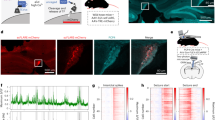Abstract
Major advances in the identification of genes implicated in idiopathic epilepsy have been made. Generalized epilepsy with febrile seizures plus (GEFS+), benign familial neonatal convulsions and nocturnal frontal lobe epilepsy, three autosomal dominant idiopathic epilepsies, result from mutations affecting voltage-gated sodium and potassium channels, and nicotinic acetylcholine receptors, respectively1,2,3,4,5,6. Disruption of GABAergic neurotransmission mediated by γ-aminobutyric acid (GABA) has been implicated in epilepsy for many decades7. We now report a K289M mutation in the GABAA receptor γ2-subunit gene (GABRG2) that segregates in a family with a phenotype closely related to GEFS+ (ref. 8), an autosomal dominant disorder associating febrile seizures and generalized epilepsy previously linked to mutations in sodium channel genes1,2. The K289M mutation affects a highly conserved residue located in the extracellular loop between transmembrane segments M2 and M3. Analysis of the mutated and wild-type alleles in Xenopus laevis oocytes confirmed the predicted effect of the mutation, a decrease in the amplitude of GABA-activated currents. We thus provide the first genetic evidence that a GABAA receptor is directly involved in human idiopathic epilepsy.
This is a preview of subscription content, access via your institution
Access options
Subscribe to this journal
Receive 12 print issues and online access
$209.00 per year
only $17.42 per issue
Buy this article
- Purchase on Springer Link
- Instant access to full article PDF
Prices may be subject to local taxes which are calculated during checkout



Similar content being viewed by others
Accession codes
References
Wallace, R.H. et al. Febrile seizures and generalized epilepsy associated with a mutation in the Na+-channel β1 subunit gene SCN1B. Nature Genet. 19, 366–370 (1998).
Escayg, A. et al. Mutations of SCN1A, encoding a neuronal sodium channel, in two families with GEFS+2. Nature Genet. 24, 343–345 (2000).
Singh, N.A. et al. A novel potassium channel gene, KCNQ2, is mutated in an inherited epilepsy of newborns. Nature Genet. 18, 25–29 (1998).
Charlier, C. et al. A pore mutation in a novel KQT-like potassium channel gene in an idiopathic epilepsy family. Nature Genet . 18, 53–55 (1998).
Steinlein, O.K. et al. A missense mutation in the neuronal nicotinic acetylcholine receptor α4 subunit is associated with autosomal dominant nocturnal frontal lobe epilepsy. Nature Genet. 11, 201–203 (1995).
Fusco, M.D. et al. The nicotinic receptor β2 subunit is mutant in nocturnal frontal lobe epilepsy. Nature Genet. 26, 275–276 (2000).
Olsen, R.W., DeLorey, T.M., Gordey, M. & Kang, M.H. GABA receptor function and epilepsy. Adv. Neurol. 79, 499–510 (1999).
Scheffer, I.E. & Berkovic, S.F. Generalized epilepsy with febrile seizures plus. A genetic disorder with heterogeneous clinical phenotypes. Brain 120, 479–490 (1997).
Baulac, S. et al. A second locus for familial generalized epilepsy with febrile seizures plus maps to chromosome 2q21–q33. Am. J. Hum. Genet. 65, 1078–1085 (1999).
Moulard, B. et al. Identification of a new locus for generalized epilepsy with febrile seizures plus (GEFS+) on chromosome 2q24–q33. Am. J. Hum. Genet. 65, 1396–1400 (1999).
Lopes-Cendes, I. et al. A new locus for generalized epilepsy with febrile seizures plus maps to chromosome 2. Am. J. Hum. Genet. 66, 698–701 (2000).
Mehta, A.K. & Ticku, M.K. An update on GABAA receptors. Brain Res. Rev. 29, 196–217 (1999).
Sieghart, W. et al. Structure and subunit composition of GABAA receptors. Neurochem. Int. 34, 379–385 (1999).
Wilcox, A.S. et al. Human chromosomal localization of genes encoding the γ 1 and γ 2 subunits of the γ-aminobutyric acid receptor indicates that members of this gene family are often clustered in the genome. Proc. Natl. Acad. Sci. USA 89, 5857–5861 (1992).
Kostrzewa, M. et al. Assignment of genes encoding GABAA receptor subunits α 1, α 6, β 2, and γ 2 to a YAC contig of 5q33. Eur. J. Hum. Genet. 4, 199–204 (1996).
Sigel, E., Buhr, A. & Baur, R. Role of the conserved lysine residue in the middle of the predicted extracellular loop between M2 and M3 in the GABAA receptor. J. Neurochem. 73, 1758–1764 (1999).
Boileau, A.J. & Czajkowski, C. Identification of transduction elements for benzodiazepines modulation of the GABAA receptor: three residues are required for allosteric coupling. J. Neurosci. 19, 10213–10220 (1999).
Elmslie, F.V. et al. Analysis of GLRA1 in hereditary and sporadic hyperekplexia: a novel mutation in a family cosegregating for hyperekplexia and spastic paraparesis. J. Med. Genet. 33, 435–436 (1996).
Aridor, M. & Balch, W.E. Integration of endoplasmic reticulum signaling in health and disease. Nature Med. 5, 745–751 (1999).
Ressot, C., Gomès, D., Dautigny, A., Pham-Dinh, D. & Bruzzone, R. Connexin32 mutations associated with X-linked Charcot-Marie-Tooth disease show two distinct phenotypes: loss of function and altered gating properties. J. Neurosci. 18, 4063–4075 (1998).
Krieg, P.A. & Melton, D.A. Functional messenger RNAs are produced by SP6 in vitro transcription of cloned cDNAs. Nucleic Acids Res. 12, 7057–7070 (1984).
Acknowledgements
We thank M. Ruberg for critically reading the manuscript. This work was funded by the Association pour le Développement de la Recherche sur les Maladies Génétiques Neurologiques et Psychiatriques, the Association Française contre les Myopathies, the Association RETINA France, Généthon and the Association pour la Recherche sur la Génétique des Epilepsies sponsored by Sanofi-Synthelabo.
Author information
Authors and Affiliations
Corresponding author
Rights and permissions
About this article
Cite this article
Baulac, S., Huberfeld, G., Gourfinkel-An, I. et al. First genetic evidence of GABAA receptor dysfunction in epilepsy: a mutation in the γ2-subunit gene. Nat Genet 28, 46–48 (2001). https://doi.org/10.1038/ng0501-46
Received:
Accepted:
Issue Date:
DOI: https://doi.org/10.1038/ng0501-46
This article is cited by
-
Genetic generalized epilepsies in adults — challenging assumptions and dogmas
Nature Reviews Neurology (2022)
-
Neocortex- and hippocampus-specific deletion of Gabrg2 causes temperature-dependent seizures in mice
Cell Death & Disease (2021)
-
Genetic Epilepsy Syndromes Without Structural Brain Abnormalities: Clinical Features and Experimental Models
Neurotherapeutics (2014)
-
Molecular modelling of the interactions of carbamazepine and a nicotinic receptor involved in the autosomal dominant nocturnal frontal lobe epilepsy
British Journal of Pharmacology (2002)



